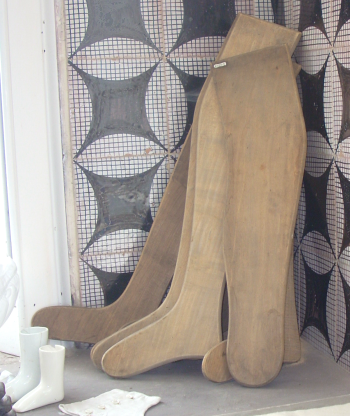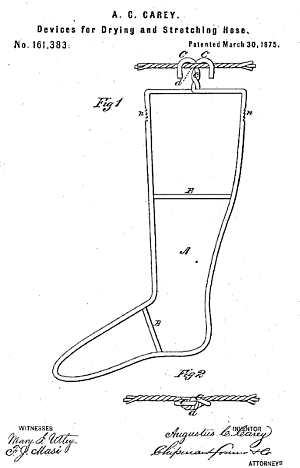
In the late 1940s a Canadian housewife, Joan Colborne,† counted her sock stretchers before tackling a backlog of laundry. She “only” had four pairs and so could not wash more than eight woollen socks at a time. If socks were not stretched out while drying they might shrink.
Stretchers like the ones in the photo were the best way of keeping socks and stockings the right size and shape after laundering. If they had holes all over to help air circulate so much the better. The flat wooden legs, clad in long woolly socks, were hung from outdoor clotheslines or given a place to dry indoors.
Since long socks always used to be called stockings, or hose, these wooden leg shapes were originally called stocking stretchers or airers, but the name sock stretchers was more common by the mid-20th century.
They were used by manufacturers as well as at home: an industrial invention with benefits for people doing domestic chores. Hosiery producers sometimes called them stocking boards.
By the time of World War I stretchers seemed so important for sock care that the Red Cross and other people knitting socks for soldiers sometimes sent stocking stretchers along too.
At Caldwell, under the direction of Mr. Howard D. Thayer, a number of stocking stretchers have been made for the soldiers’ use. (1918 New Jersey School Bulletin)
Wire stretchers

Sometimes you see metal sock stretchers made of wire. As long as they were truly rust-free they were probably a better design: more air passing through, and no damp, warped wood. A patent in 1875 seems to be claiming inventor’s rights over the idea of using wire for stocking stretchers, while also patenting other new features in “devices for drying and stretching hose”. The patentee, Augustus C. Carey, was described as “the inventor of more than 100 valuable electrical and mechanical devices” in an obituary.
Although stocking stretchers were certainly used in Britain, especially in big households, it seems that they were most popular in North America. After World War II, when a few more sock stretchers were provided to the troops, there was news of socks that would not shrink. American ads stressed that you could now manage without the hassle of using sock stretchers.
Throw away those annoying sock-stretchers — just wash Sarfert Socks in the usual way. They’ll not only keep their knitted size after many washings, but they’ll wear longer and stay soft and pliant as when new. (1947 ad)
DuPont nylon will keep their shape, looks, and smartness for a long, long time. Throw away your sock stretchers too because under normal washing conditions these new Bear Brand honeys won’t shrink, won’t stretch, they’ll always fit. (1949 ad)

Some people still expected sock stretchers to stick around for a long time. In 1948 the Spokane Daily Chronicle published a sceptical column titled Put-up-or-shut-up Policy Issued Against Science?.
As for woolens that won’t shrink, I see that sock stretchers are still being sold… (Henry McLemore)
Sock blockers

Well, that journalist was partly wrong, and partly right. Sock stretchers have come back. A few people use them for wet wool hiking socks, and they’re also popular with knitters, who call them sock blockers. A new generation of hand-knitters use sock blockers to shape up newly-knitted socks. Blocking means encouraging pieces of newly hand-knit fabric to take their intended shape: by dampening, pressing, pinning etc. Sock blockers is a 21st century name for the 2-dimensional wooden legs, although knitters have used “blocking” techniques for longer. I found a couple of mentions of sock blockers before the new millennium, but the name really only took off after the year 2000.
Notes
†See: Joan Colborne, Letters from the Manse, 2003
Photos
Photographers credited in captions. Links to originals and/or licenses: sock blockers by ulygan, or see more picture info here
Unfortunately, the link to the “Stocking Boards” is dead…
couldn’t find the new URL as that side shows no search functionality
LikeLike